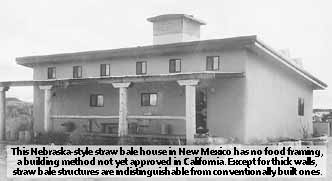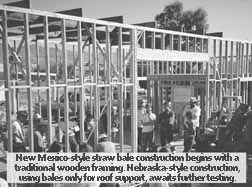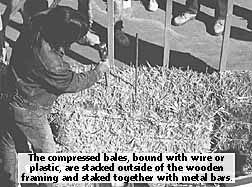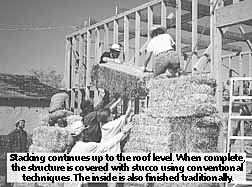






Straw bale construction:
try huffing and puffing these houses down
It's no fairy tale. Although straw bale homes conjure up images of the
fabled first little pig's straw house, no amount of huffing and puffing
- or strong winds, for that matter - can blow these homes down.
by Lorin Hallinan
 f Jim Danielson has his way, more homes in San Diego
County will be built using a resource that never seems to run out. Danielson,
who has been in the construction business for 10 years, would like to build
homes using bales of straw. They're far from flimsy. Once covered with stucco
or similar material, straw bale is extremely fire resistant, Danielson pointed
out. Examples of his sturdy work using straw-bale construction have been
featured at environmentally-conscious events such as Earth Day in Balboa
Park.
f Jim Danielson has his way, more homes in San Diego
County will be built using a resource that never seems to run out. Danielson,
who has been in the construction business for 10 years, would like to build
homes using bales of straw. They're far from flimsy. Once covered with stucco
or similar material, straw bale is extremely fire resistant, Danielson pointed
out. Examples of his sturdy work using straw-bale construction have been
featured at environmentally-conscious events such as Earth Day in Balboa
Park.
 The way Danielson sees it, straw-bale construction is
a responsible gesture toward Mother Nature, and one that makes sense. Instead
of seeing the dry grain stems burned or buried or simply wasted, Danielson
believes the byproduct can be put to good use. Since cereal grains are grown
in most states, there would be plenty of straw to go around. "Straw
bale is an annual renewable resource, unlike timber that can take 30 or
more years to come back," he noted. "There's an awful lot of people
I've talked to who have heard about straw bale. It's just a matter of time
before we can get the building department to cooperate."
The way Danielson sees it, straw-bale construction is
a responsible gesture toward Mother Nature, and one that makes sense. Instead
of seeing the dry grain stems burned or buried or simply wasted, Danielson
believes the byproduct can be put to good use. Since cereal grains are grown
in most states, there would be plenty of straw to go around. "Straw
bale is an annual renewable resource, unlike timber that can take 30 or
more years to come back," he noted. "There's an awful lot of people
I've talked to who have heard about straw bale. It's just a matter of time
before we can get the building department to cooperate."
 Through his business Epic Living, Danielson has submitted
three proposals to build straw bale homes in the county, including 38 acres
in Fallbrook and several thousand acres on an Indian reservation.
Through his business Epic Living, Danielson has submitted
three proposals to build straw bale homes in the county, including 38 acres
in Fallbrook and several thousand acres on an Indian reservation.
 If Danielson's proposals go through and investment money
comes in, Jim Bell will come on board as the ecology consultant. Bell, an
ecological designer at the Ecological Life Systems Institute in San Diego,
is considered a leading authority and expert in his field.
If Danielson's proposals go through and investment money
comes in, Jim Bell will come on board as the ecology consultant. Bell, an
ecological designer at the Ecological Life Systems Institute in San Diego,
is considered a leading authority and expert in his field.
 Bell works with individuals and businesses to help them
improve methods of doing things that make sense economically and ecologically.
He supports the belief that straw-bale construction makes sense. "Straw
is a naturally occurring material, and if used properly in a structure,
it's very durable and also an excellent insulator," said Bell. "If
a house is built and serves its purpose for 100 years, the major materials,
meaning straw, could break down and go back into nature. That's what we
need to look toward. In long terms, it's a cradle-to-cradle resource movement."
Bell works with individuals and businesses to help them
improve methods of doing things that make sense economically and ecologically.
He supports the belief that straw-bale construction makes sense. "Straw
is a naturally occurring material, and if used properly in a structure,
it's very durable and also an excellent insulator," said Bell. "If
a house is built and serves its purpose for 100 years, the major materials,
meaning straw, could break down and go back into nature. That's what we
need to look toward. In long terms, it's a cradle-to-cradle resource movement."

Old and new
 The compressed rectangular bales of straw used in building
usually come in two versions, either two-tie or three-tie bales. Tied with
plastic string or wire, the smaller version measures 18 inches wide, 14
inches high and 36 to 42 inches long and weighs about 55 pounds. The three-tie
version weighs about 80 pounds and measures 23 inches wide, 16 inches high
and 42 to 48 inches long.
The compressed rectangular bales of straw used in building
usually come in two versions, either two-tie or three-tie bales. Tied with
plastic string or wire, the smaller version measures 18 inches wide, 14
inches high and 36 to 42 inches long and weighs about 55 pounds. The three-tie
version weighs about 80 pounds and measures 23 inches wide, 16 inches high
and 42 to 48 inches long.
 As novel as the construction method sounds, it's not
new. Straw-bale construction dates back to the last century. Homesteaders
in Nebraska started using straw bale to build homes in the late 1800s, out
of necessity. With timber in short supply, people turned to the renewable
resource they had on hand - straw from wheat, barley and rye harvests.
As novel as the construction method sounds, it's not
new. Straw-bale construction dates back to the last century. Homesteaders
in Nebraska started using straw bale to build homes in the late 1800s, out
of necessity. With timber in short supply, people turned to the renewable
resource they had on hand - straw from wheat, barley and rye harvests.
 Unfortunately, Nebraska-style straw bale homes are illegal
to build in many states, including California and New Mexico. Not enough
tests have been done to convince building department authorities of their
stability.
Unfortunately, Nebraska-style straw bale homes are illegal
to build in many states, including California and New Mexico. Not enough
tests have been done to convince building department authorities of their
stability.
 With the Nebraska method compressed bales of straw serve
as the main support for the roof. Using this load-bearing technique, a continuous
beam is placed around the house's upper wall on top of stacked straw bales,
and then a roof is put on top of that. (Think of them as big bricks.) The
technique does not comply with the Uniform Building Code, which dictates
the way homes can be built in many Western states.
With the Nebraska method compressed bales of straw serve
as the main support for the roof. Using this load-bearing technique, a continuous
beam is placed around the house's upper wall on top of stacked straw bales,
and then a roof is put on top of that. (Think of them as big bricks.) The
technique does not comply with the Uniform Building Code, which dictates
the way homes can be built in many Western states.
 The thumbs-down reception given to Nebraska-style straw-bale
construction isn't holding Danielson back. He's adjusting to the obstacle
by promoting a rendition of the Nebraska home, one that uses straw bales
as insulative infill rather than support. Wooden post and beam framework
would bear the load of heavy roofs, which satisfies building code requirements.
Concrete slabs would keep the straw dry and off the ground, and chicken
wire around the straw would provide a surface for stucco to be applied.
Stucco sealants, ample roof overhangs and well-maintained exterior wall
surfaces keep out moisture and humidity out.
The thumbs-down reception given to Nebraska-style straw-bale
construction isn't holding Danielson back. He's adjusting to the obstacle
by promoting a rendition of the Nebraska home, one that uses straw bales
as insulative infill rather than support. Wooden post and beam framework
would bear the load of heavy roofs, which satisfies building code requirements.
Concrete slabs would keep the straw dry and off the ground, and chicken
wire around the straw would provide a surface for stucco to be applied.
Stucco sealants, ample roof overhangs and well-maintained exterior wall
surfaces keep out moisture and humidity out.
 As far as insects are concerned, straw bale is usually
not on the menu. For one thing, straw has virtually no nutrients and common
house eaters, like termites, devour wood not straw.
As far as insects are concerned, straw bale is usually
not on the menu. For one thing, straw has virtually no nutrients and common
house eaters, like termites, devour wood not straw.



New Mexico bales out
 New Mexico is one state leading the way in new construction
of straw-bale homes. The only state that controls building at the state
level rather than the county level, New Mexico is in the process of incorporating
an amendment to its building code to allow for more homes to be constructed
using straw bale.
New Mexico is one state leading the way in new construction
of straw-bale homes. The only state that controls building at the state
level rather than the county level, New Mexico is in the process of incorporating
an amendment to its building code to allow for more homes to be constructed
using straw bale.
 According to Tony Perry, who owns Straw Bale Construction
Management Inc. in Santa Fe, New Mexico, once the amendment goes through,
people in other states will most likely pay attention to it and ask for
engineering data and other information. "Obviously, they'll have to
make up their own minds," said Perry, an Englishman who's enthusiasm
for straw bale homes led him to found his consultancy company that serves
to help architects and builders. He has lived in Santa Fe since 1990 and
serves as chairman of the New Mexico Technical Advisory Committee and as
president of the national Straw-Bale Construction Association.
According to Tony Perry, who owns Straw Bale Construction
Management Inc. in Santa Fe, New Mexico, once the amendment goes through,
people in other states will most likely pay attention to it and ask for
engineering data and other information. "Obviously, they'll have to
make up their own minds," said Perry, an Englishman who's enthusiasm
for straw bale homes led him to found his consultancy company that serves
to help architects and builders. He has lived in Santa Fe since 1990 and
serves as chairman of the New Mexico Technical Advisory Committee and as
president of the national Straw-Bale Construction Association.
 Perry, like Danielson, has been so swayed by straw bale's
potential, he's convinced many people in the area to jump on the bandwagon.
Perry has spent more than a year lobbying the New Mexico state government
to permit experimental housing. At the end of 1993, New Mexico officials
agreed to allow 10 experimental permits. They soon expanded the number to
20, and this summer decided to allow an unlimited number of experimental
permits.
Perry, like Danielson, has been so swayed by straw bale's
potential, he's convinced many people in the area to jump on the bandwagon.
Perry has spent more than a year lobbying the New Mexico state government
to permit experimental housing. At the end of 1993, New Mexico officials
agreed to allow 10 experimental permits. They soon expanded the number to
20, and this summer decided to allow an unlimited number of experimental
permits.
 Perry said about 80 owner/builder homes are occupied
or in the planning stages right now. The homes range in size from 600 square
feet to 8,000 square feet, with several falling into the 3,000-square-foot
category. "It's clear to me that it's going to grow and grow and grow,"
said Perry.
Perry said about 80 owner/builder homes are occupied
or in the planning stages right now. The homes range in size from 600 square
feet to 8,000 square feet, with several falling into the 3,000-square-foot
category. "It's clear to me that it's going to grow and grow and grow,"
said Perry.
Big cost savings
 Under contract with the federal government, the Technical
Advisory Committee, which advises New Mexico's building bureaucracy, recently
conducted a feasibility study about straw bale. With the help of the New
Mexico School of Architecture, design work has been completed and two prototype
homes will be built to feature straw-bale homes as alternative, affordable
housing. "If you design them properly and subcontract out different
bits, even have family and friends help build the house, we believe you
can cut the cost by 40 percent to 50 percent," said Perry.
Under contract with the federal government, the Technical
Advisory Committee, which advises New Mexico's building bureaucracy, recently
conducted a feasibility study about straw bale. With the help of the New
Mexico School of Architecture, design work has been completed and two prototype
homes will be built to feature straw-bale homes as alternative, affordable
housing. "If you design them properly and subcontract out different
bits, even have family and friends help build the house, we believe you
can cut the cost by 40 percent to 50 percent," said Perry.
 The homes, which have an adobe look to them, are very
attractive, Perry pointed out, because the walls are thick and solid, typically
22 inches thick. They're so thermally efficient, he added, that utility
bills plummet.
The homes, which have an adobe look to them, are very
attractive, Perry pointed out, because the walls are thick and solid, typically
22 inches thick. They're so thermally efficient, he added, that utility
bills plummet.
 Perry recently was involved in a test conducted for
the federal government that compared utility bills from conventional wooden
homes with bills from straw-bale homes. The straw-bale houses saved as much
as 75 percent on utilities.
Perry recently was involved in a test conducted for
the federal government that compared utility bills from conventional wooden
homes with bills from straw-bale homes. The straw-bale houses saved as much
as 75 percent on utilities.
 They're cheaper to build, too. Danielson, who plans
to build two straw-bale homes for his own use on land he owns in the Mt.
Shasta area, estimates they cost about $10 a square foot to build, compared
to $80 to $100 for conventional homes in San Diego County.
They're cheaper to build, too. Danielson, who plans
to build two straw-bale homes for his own use on land he owns in the Mt.
Shasta area, estimates they cost about $10 a square foot to build, compared
to $80 to $100 for conventional homes in San Diego County.
 The homes may well be the best thing that ever happened
in terms of affordability, but are they safe? According to Perry, prototypes
fared remarkably well in fire rating, wind load and insulation tests performed
by independent professionals.
The homes may well be the best thing that ever happened
in terms of affordability, but are they safe? According to Perry, prototypes
fared remarkably well in fire rating, wind load and insulation tests performed
by independent professionals.
Safe and sane
 During a two-hour fire test, for instance, a section
of a wall constructed with straw bale was placed against a furnace. Within
five minutes, the temperature shot up to 1,000 degrees Fahrenheit, then
1,750 degrees after 60 minutes. "Wood catches fire at 500 degrees,"
noted Perry. "If the wall had been wood, it would have burned. If it
had been steel, it would have buckled."
During a two-hour fire test, for instance, a section
of a wall constructed with straw bale was placed against a furnace. Within
five minutes, the temperature shot up to 1,000 degrees Fahrenheit, then
1,750 degrees after 60 minutes. "Wood catches fire at 500 degrees,"
noted Perry. "If the wall had been wood, it would have burned. If it
had been steel, it would have buckled."
 To pass the test, the temperature of the wall on its
cool side could not exceed 250 degrees or have any flames penetrate it.
After one hour, the temperature on the cool side had actually dropped two
degrees, according to Perry, because a fan had been blowing. As the temperature
on the hot side topped out at 1,940 degrees, the cool side temperature rose
only 12.7 degrees! Remember, it could heat up to 250 degrees before failing
the test.
To pass the test, the temperature of the wall on its
cool side could not exceed 250 degrees or have any flames penetrate it.
After one hour, the temperature on the cool side had actually dropped two
degrees, according to Perry, because a fan had been blowing. As the temperature
on the hot side topped out at 1,940 degrees, the cool side temperature rose
only 12.7 degrees! Remember, it could heat up to 250 degrees before failing
the test.
 For the wind test, the equivalent of a 75 mph gale was
directed at the wall. To pass the test, the wall could not move more than
3/8 inch. "We had no movement at all," said Perry. "We took
it up to 100 mph and it moved only 1/16 inch."
For the wind test, the equivalent of a 75 mph gale was
directed at the wall. To pass the test, the wall could not move more than
3/8 inch. "We had no movement at all," said Perry. "We took
it up to 100 mph and it moved only 1/16 inch."
 To prove straw bale's superb insulation benefits, testers
examined the material's "R" factor, a numbered rating system used
to determine how well a material insulates. Higher numbers indicate relatively
better insulation.
To prove straw bale's superb insulation benefits, testers
examined the material's "R" factor, a numbered rating system used
to determine how well a material insulates. Higher numbers indicate relatively
better insulation.
 A six-inch wooden wall with fiberglass insulation, for
example, carries an R factor of 19. The average roof rates R30. One bale
of straw without any plastering rated R48. "That's why utility bills
go down," said Perry. "We've taken a very thorough, professional
approach to this and had all the tests done by outside professionals. Everything
was done according to acceptable standards, which is why the state has moved
forward."
A six-inch wooden wall with fiberglass insulation, for
example, carries an R factor of 19. The average roof rates R30. One bale
of straw without any plastering rated R48. "That's why utility bills
go down," said Perry. "We've taken a very thorough, professional
approach to this and had all the tests done by outside professionals. Everything
was done according to acceptable standards, which is why the state has moved
forward."
 Danielson hopes San Diego can follow suit, as well as
the rest of the country. "I want to be doing this across the United
States," said Danielson, who currently pursues the straw-bale part
of his business part-time. "I want to change from timber homes to alternative
building styles. I want to decentralize energy sources so people can use
their own electricity and water. It makes a whole lot of sense. My motivation
is preserving our natural resources and making people responsible and self-sufficient.
What we're doing now doesn't make sense."
Danielson hopes San Diego can follow suit, as well as
the rest of the country. "I want to be doing this across the United
States," said Danielson, who currently pursues the straw-bale part
of his business part-time. "I want to change from timber homes to alternative
building styles. I want to decentralize energy sources so people can use
their own electricity and water. It makes a whole lot of sense. My motivation
is preserving our natural resources and making people responsible and self-sufficient.
What we're doing now doesn't make sense."

Lorin Hallinan is a freelance author and former Editor for the Coast
Dispatch and Carlsbad Journal community newspapers. A 13-year San Diego
resident, she lives in Carlsbad, with her 15-year-old cat, Hansel.









